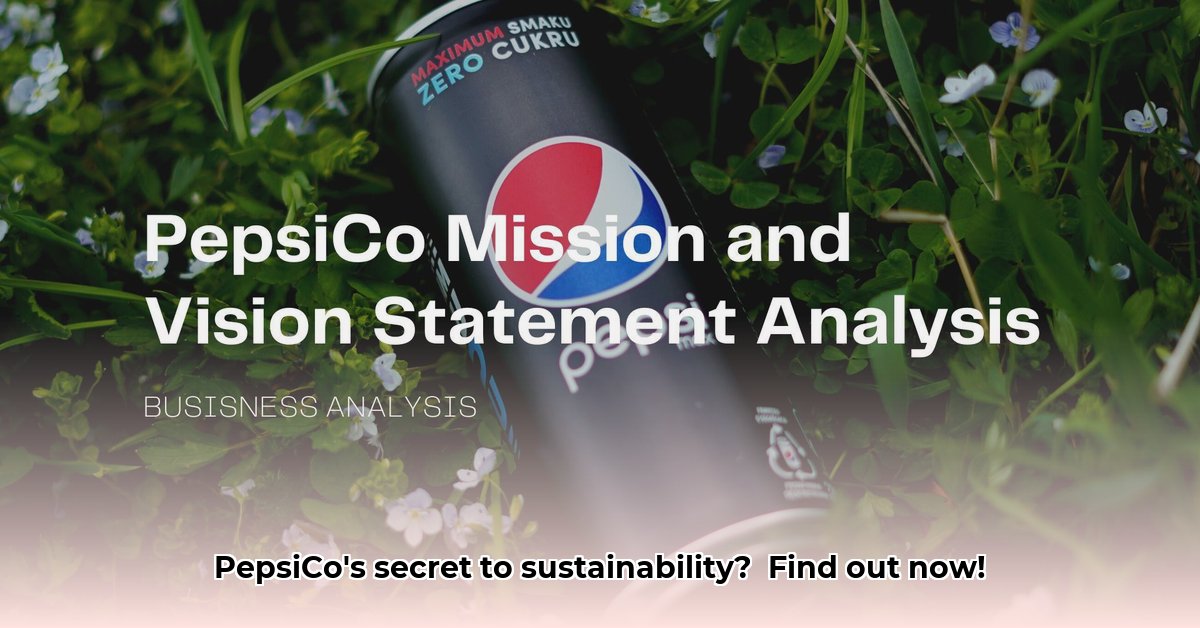
PepsiCo's pep+ Initiative: A Deep Dive into Sustainability
PepsiCo's pep+ (PepsiCo Positive) initiative represents a bold commitment to sustainable business practices. This long-form analysis examines the company's ambitious goals, its implementation strategies, and the challenges it faces in balancing profitability with environmental and social responsibility. We will explore the initiative's successes, shortcomings, and the crucial role of transparency in building trust with stakeholders. Does pep+ truly represent a meaningful shift towards a sustainable future, or is it simply greenwashing? Let's investigate.
How does PepsiCo define its mission within the context of pep+? The core of PepsiCo's mission, as embodied in pep+, transcends simple profit maximization. It aims to achieve sustainable growth, intertwining business success with environmental stewardship and social impact. This ambitious goal necessitates a complex strategy encompassing numerous facets of their operations.
The pep+ Promise: Ambitions and Challenges
PepsiCo frames pep+ with the aspirational goal of being "Faster, Stronger, and Better." This encapsulates improvements across their entire value chain, from sustainable agriculture to responsible packaging and positive societal impact. The initiative targets significant reductions in environmental impact and a more equitable business model. However, the lack of precise, measurable targets presents a significant challenge. Without specific benchmarks (e.g., "reduce water usage by X% by Y year"), it's difficult to objectively assess progress and hold PepsiCo accountable. This inherent ambiguity raises a key question: How can PepsiCo ensure that its broad, ambitious goals translate into tangible, measurable results?
A Global Strategy with Localized Approaches
PepsiCo’s pep+ strategy, while global in scope, employs a localized approach. This tailored strategy recognizes the unique environmental and social contexts of different regions. For instance, their focus may vary significantly between North America and regions like Australia and New Zealand. While this adaptability offers practical advantages, it also introduces complexities. The inconsistency in regional focus might hinder the establishment of uniform, globally-applicable standards and metrics, making comprehensive evaluation of pep+'s overall effectiveness difficult. This leads to another critical question: Does this localized approach optimize effectiveness, or does it create fragmentation that impedes overall progress?
Navigating the Risks: Potential Pitfalls and Mitigation Strategies
PepsiCo's pep+ initiative faces considerable risks. Failure to deliver on its ambitious promises could severely damage the company's reputation and erode investor confidence. The substantial financial investments required also introduce significant financial risk. Furthermore, operational disruptions within its complex global supply chain pose a major challenge. The following table summarizes key risks and potential mitigation strategies:
| Risk Category | Likelihood | Impact | Mitigation Strategy |
|---|---|---|---|
| Reputation Damage | Moderate | High | Enhanced transparency, proactive stakeholder engagement, rapid response to criticisms. |
| Financial Losses | Moderate | High | Diversified investments, robust risk management, contingency planning. |
| Operational Disruptions | High | Moderate | Efficient project management, clear communication, technological optimization. |
| Regulatory Non-Compliance | Moderate | Moderate | Continuous monitoring of regulations, proactive engagement with lawmakers, agile adaptation. |
| Supply Chain Vulnerabilities | High | Moderate | Diversified sourcing, ethical and sustainable supply chain partnerships. |
Collaboration and Accountability: A Multi-Stakeholder Approach
The success of pep+ hinges on effective collaboration across multiple stakeholders. PepsiCo's leadership plays a crucial role in setting measurable goals and fostering transparency. Investors require transparent reporting on environmental and social impact. Consumers demand sustainable products and honest communication. Employees require adequate training and a supportive work environment. Suppliers must embrace sustainable practices, and government bodies and NGOs must actively participate in the process. These interdependent factors highlight the importance of a cohesive, cooperative ecosystem for the overall success of PepsiCo's ambitious sustainability agenda.
The Path Forward: Transparency and Continuous Improvement
PepsiCo's pep+ journey is a long-term commitment that will require consistent improvement and adaptation. A renewed focus on transparency and accountability is paramount. The establishment of clear, measurable goals, transparent progress reporting, and open communication are crucial steps toward achieving a sustainable future. The journey may be lengthy and challenging, but only through consistent rigorous self-assessment and a commitment to transparency can PepsiCo ensure the credibility and lasting impact of its pep+ initiative. The ongoing nature of this endeavor underscores the need for continuous monitoring, evaluation, and adaptation – a crucial component in their pursuit of a more sustainable future.
Key Takeaways:
- PepsiCo's pep+ initiative, while ambitious, lacks the granular detail required for independent verification of its sustainability claims.
- Transparency is crucial for building stakeholder trust and ensuring accountability.
- Continued improvements in data accessibility and methodological transparency are essential for effective assessment of pep+'s progress.
- Independent audits and robust stakeholder engagement are necessary for building confidence in the initiative's long-term success.